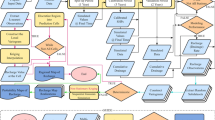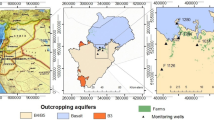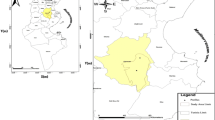Abstract
Managed aquifer recharge (MAR) is increasingly used to balance out the divergence between natural groundwater recharge and overexploitation of groundwater resources. As testing and design of recharge facilities can be cost and time-intensive, modeling tools hold great potential to design field investigations as well as to augment and extrapolate from their results. Focusing on unsaturated soil zone models, this study first reviews 16 previous modeling studies showing their range of model types and applications. The review is accompanied by an example of the use of HYDRUS 2D/3D, an unsaturated zone model, to design a novel small-scale infiltration basin. The basin is going to be established as part of a field and laboratory research facility for MAR in Pirna, Germany. Modeling results assisted in determining the dimensions of the infiltration unit as well as the placement of measurement devices and experimental scenario planning. Finally, the strengths and constraints of this modeling approach for MAR assessment are discussed.







Similar content being viewed by others
Abbreviations
- MAR:
-
Managed aquifer recharge
- BC:
-
Boundary condition
- SAT:
-
Soil aquifer treatment
- ASR:
-
Aquifer storage and recovery
- ASTR:
-
Aquifer storage, transfer and recovery
References
Anderson MP, Woessner WW, Hunt RJ (2015) Applied groundwater modeling: simulation of flow and advective transport. Academic Press, New York
Arunakumaren NJ (1997) A lumped parameter model for simulating the temporal behaviour of moisture in the plant root zone and in the unsaturated zone below the root zone. Resource Sciences Centre, Department of Natural Resources, Queensland
Assouline S (2013) Infiltration into soils: conceptual approaches and solutions: review: infiltration into soils. Water Resour Res 49:1755–1772. https://doi.org/10.1002/wrcr.20155
Azaroual M, Thiéry D, Amraoui N et al (2012) Physical, geochemical and microbial processes induced during the aquifer recharge using treated wastewaters: laboratory and pilot experiments and numerical simulations. In: Draeger M (ed) Achieving groundwater supply sustainability & reliability through managed aquifer recharge—Proceedings of the Symposium ISMAR 7, 9–13 October 2009, Abu Dhabi, UAE, pp 170–177
Azaroual M, Pettenati M, Ollivier P et al (2013) Reactive transfer of pollutants through the unsaturated soil zone during an artificial aquifer recharge process. Procedia Earth Planet Sci 7:40–43. https://doi.org/10.1016/j.proeps.2013.03.169
Bekele E, Toze S, Patterson B, Higginson S (2011) Managed aquifer recharge of treated wastewater: water quality changes resulting from infiltration through the vadose zone. Water Res 45:5764–5772. https://doi.org/10.1016/j.watres.2011.08.058
Bhola PK, Zabel AK, Rajaveni SP, et al (2013) Integrated surface water and groundwater modeling for optimizing MAR structures in the Chennai region. In: 8th Annual International Symposium on Managed Aquifer Recharge - ISMAR8. Beijing
Brooks R, Corey T (1964) Hydraulic properties of porous media. Hydrology Papers Colorado State University
Browne D, Deletic A, Fletcher T, Mudd G (2011) Modeling the development and consequences of clogging for stormwater infiltration trenches. Porto Alegre, Brazil
Brutsaert W (1966) Probability laws for pore-size distributions. Soil Sci 101:85–92
Carsel RF, Parrish RS (1988) Developing joint probability distributions of soil water retention characteristics. Water Resour Res 24:755–769. https://doi.org/10.1029/WR024i005p00755
Crosbie RS, Scanlon BR, Mpelasoka FS et al (2013) Potential climate change effects on groundwater recharge in the High Plains Aquifer, USA. Water Resour Res 49:3936–3951. https://doi.org/10.1002/wrcr.20292
Dann R, Close M, Flintoft M et al (2009) Characterization and estimation of hydraulic properties in an alluvial gravel vadose zone. Vadose Zone J 8:651. https://doi.org/10.2136/vzj2008.0174
Diersch H-J (2014) FEFLOW / finite element modeling of flow, mass and heat transport in porous and fractured media. Springer, Berlin; Heidelberg [u.a.]
Dietze M, Dietrich P (2012) Evaluation of vertical variations in hydraulic conductivity in unconsolidated sediments. Ground Water 50:450–456. https://doi.org/10.1111/j.1745-6584.2011.00854.x
Dillon P (2005) Future management of aquifer recharge. Hydrogeol J 13:313–316. https://doi.org/10.1007/s10040-004-0413-6
DIN Deutsches Institut für Normung e.V (2008) Bodenkundliche Standortbeurteilung—Kennzeichnung, Klassifizierung und Ableitung von Bodenkennwerten (normative und nominale Skalierungen)
Durner W (1994) Hydraulic conductivity estimation for soils with heterogeneous pore structure. Water Resour Res 30:211–223. https://doi.org/10.1029/93WR02676
El Arabi NE, Dawoud MA (2012) Groundwater aquifer recharge with treated wastewater in Egypt: technical, environmental, economical and regulatory considerations. Desalination Water Treat 47:266–278. https://doi.org/10.1080/19443994.2012.696405
Environmental and Water Resources Institute (ed) (2001) Standard guidelines for artificial recharge of ground water. American Society of Civil Engineers, Reston
Fedoroff NV, Battisti DS, Beachy RN et al (2010) Radically Rethinking Agriculture for the 21st Century. Sci 327(5967):833–834. https://doi.org/10.1126/science.1186834
Fernández-Escalante AE (2013) Practical criteria in the design and maintenance of MAR facilities in order to minimise clogging impacts obtained from two different operative sites in Spain. In: Martin R (ed) Clogging issues associated with managed aquifer recharge methods. IAH Commission on Managing Aquifer Recharge, Australia, pp 119–154
Flint AL (2002) The Role of Unsaturated Flow in Artificial Recharge Projects. In: Aiken GR, Kuniansky EL (eds) U.S. Geological Survey Artificial Recharge Workshop Proceedings. Sacramento, California, pp 13–15
Gaus I, Cikurel H, Aharoni A et al (2007) Alternative SAT of secondary effluents using a combination of UF and short term SAT for increasing infiltration rates at the Shafdan site (Israel). In: Fox P (ed) Management of aquifer recharge for sustainability: proceedings of the 6th International Symposium on Managed Artificial Recharge of Groundwater, ISMAR6, Phoenix, Arizona USA October 28–November 2, 2007. Acacia Publishing Incorporated, pp 544–557
Gerke HH, van Genuchten MT (1993) A dual-porosity model for simulating the preferential movement of water and solutes in structured porous media. Water Resour Res 29:305–319. https://doi.org/10.1029/92WR02339
Glass RJ, Steenhuis TS, Parlange J-Y (1989) Mechanism for finger persistence in homogeneous, unsaturated porous media: theory and verification. Soil Sci 148:60–70. https://doi.org/10.1097/00010694-198907000-00007
Gvirtzman H, Shalev E, Dahan O, Hatzor YH (2008) Large-scale infiltration experiments into unsaturated stratified loess sediments: monitoring and modeling. J Hydrol 349:214–229. https://doi.org/10.1016/j.jhydrol.2007.11.002
Händel F, Liu G, Dietrich P et al (2014) Numerical assessment of ASR recharge using small-diameter wells and surface basins. J Hydrol 517:54–63. https://doi.org/10.1016/j.jhydrol.2014.05.003
Hannappel S, Scheibler F, Huber A, Sprenger C (2014) Characterization of European managed aquifer recharge (MAR) sites—analysis. DEMEAU project report.
Hasan I, Sallwey J, Sandhu C et al (2013) Simulation of water and solute transport in unsaturated soils by taking the example of decentralised treated wastewater infiltration. In: Proceedings of AquaConSoil Conference, Barcelona, Spain
Heilweil VM, Benoit J, Healy RW (2015) Variably saturated groundwater modelling for optimizing managed aquifer recharge using trench infiltration. Hydrol Process 29:3010–3019. https://doi.org/10.1002/hyp.10413
Jha MK, Pfeiffer O (2006) Simulation modeling of salient artificial recharge techniques for sustainable groundwater management. In: UNESCO (ed) Recharge systems for protecting and enhancing groundwater resources—Proceedings of the 5th International Symposium on Management of Aquifer Recharge ISMAR5, Berlin, Germany, 11–16 June 2005, pp 388–394
Keese KE, Scanlon BR, Reedy RC (2005) Assessing controls on diffuse groundwater recharge using unsaturated flow modeling: recharge controls. Water Resour Res. https://doi.org/10.1029/2004WR003841
Kim JH, Jackson RB (2012) A global analysis of groundwater recharge for vegetation, climate, and soils. Vadose Zone J 11:0. https://doi.org/10.2136/vzj2011.0021RA
Kloppmann W, Aharoni A, Chikurel H et al (2012) Use of groundwater models for prediction and optimisation of the behaviour of MAR sites. In: Kazner C, Wintgens T, Dillon P (eds) Water reclamation technologies for safe managed aquifer recharge. IWA Publishing, London
Kosugi K (1996) Lognormal distribution model for unsaturated soil hydraulic properties. Water Resour Res 32:2697–2703. https://doi.org/10.1029/96WR01776
Mathias SA, Butler AP, Jackson BM, Wheater HS (2006) Transient simulations of flow and transport in the Chalk unsaturated zone. J Hydrol 330:10–28. https://doi.org/10.1016/j.jhydrol.2006.04.010
McMahon GA, Arunakumaren NJ, Bajracharya K (2000) Hydrogeological conceptualisation of the Burdekin river delta. In: Hydro 2000: Interactive Hydrology, Proceedings. Barton, ACT: Institution of Engineers, Australia, pp 208–213
Monninkhoff B (2014) IfmMIKE11 2.1 Coupling the groundwater model FEFLOW® and the surface water model MIKE11®-User Manual. Berlin, WASY Software. DHI-WASY GmbH
Monninkhoff L, Kaden S (2012) Managed Aquifer Recharge through a penetrated river bed in Shandong, China. In: Draeger M (ed) Achieving groundwater supply sustainability & reliability through managed aquifer recharge - Proceedings of the Symposium ISMAR 7, 9–13 October 2009, Abu Dhabi, UAE, pp 267–274
Montgomery-Brown J, Drewes JE, Fox P, Reinhard M (2003) Behavior of alkylphenol polyethoxylate metabolites during soil aquifer treatment. Water Res 37(15):3672–3681. https://doi.org/10.1016/S0043-1354(03)00294-X
Nadav I, Arye G, Tarchitzky J, Chen Y (2012) Enhanced infiltration regime for treated-wastewater purification in soil aquifer treatment (SAT). J Hydrol 420–421:275–283. https://doi.org/10.1016/j.jhydrol.2011.12.013
NRMMC-EPHC-NHMRC (2009) Australian guidelines for water recycling. Managed Aquifer Recharge. National Water Quality Management Strategy Document No 24, Canberra. http://www.agriculture.gov.au/SiteCollectionDocuments/water/water-recycling-guidelines-mar-24.pdf. Accessed Jan 2018
Parkhurst DL, Petkewich MD (2002) Geochemical modeling of an aquifer storage recovery experiment, Charleston, South Carolina. In: US Geological Survey Artificial Recharge Workshop Proceedings Sacramento, California. Sacramento, California, p 38
Pérez-Paricio A (2001) Integrated Modeling of Clogging Processes in Artificial Groundwater Recharge. Dissertation, Technical University of Catalonia
Pérez-Paricio A, Carrera J (1998) A conceptual and numerical model to characterize clogging. In: International Symposium on Artificial Recharge of Ground Water, Peters JH (eds) Artificial recharge of groundwater: proceedings of the third International Symposium on Artificial Recharge of Groundwater: TISAR 98, Amsterdam, Netherlands, 21–25 September 1998. A.A. Balkema, Rotterdam; Brookfield, pp 55–60
Pruess K, Oldenburg C, Moridis G (2012) Tough2 user’s guide, version 2, University of California
Richards LA (1931) Capillary conduction of liquids through porous mediums. Physics 1:318. https://doi.org/10.1063/1.1745010
Ringleb J, Sallwey J, Stefan C (2016) Assessment of managed aquifer recharge through modeling—a review. Water 8:579. https://doi.org/10.3390/w8120579
Rossman NR, Zlotnik VA, Rowe CM, Szilagyi J (2014) Vadose zone lag time and potential 21st century climate change effects on spatially distributed groundwater recharge in the semi-arid Nebraska Sand Hills. J Hydrol 519 Part A:656–669. https://doi.org/10.1016/j.jhydrol.2014.07.057
Saharawat Y, Malik R, Jhorar B et al (2006) Simulating effect of successive cycles in aquifer storage and recovery well in India. In: UNESCO (ed) Recharge systems for protecting and enhancing groundwater resources—Proceedings of the 5th International Symposium on Management of Aquifer Recharge ISMAR5, Berlin, Germany, 11–16 June 2005, pp 421–427
Schaap MG, Leij FJ, van Genuchten MT (2001) rosetta: a computer program for estimating soil hydraulic parameters with hierarchical pedotransfer functions. J Hydrol 251:163–176. https://doi.org/10.1016/S0022-1694(01)00466-8
Schroeder PR, Lloyd CM, Zappi PA, Aziz NM (1994) The hydrologic evaluation of landfill performance (HELP) model: user’s guide for version 3. U.S. Environmental Protection Agency Office of Research and Development, Washington, DC
Šimůnek J (n.d.) Notes on Spatial and Temporal Discretization. https://www.pc-progress.com/Documents/Notes_on_Spatial_and_Temporal_Discretization.pdf. Accessed Jan 2018
Šimůnek J, Bradford SA (2008) Vadose zone modeling: introduction and importance. Vadose Zone J 7:581. https://doi.org/10.2136/vzj2008.0012
Šimůnek J, Jarvis NJ, van Genuchten MT, Gärdenäs A (2003) Review and comparison of models for describing non-equilibrium and preferential flow and transport in the vadose zone. J Hydrol 272:14–35. https://doi.org/10.1016/S0022-1694(02)00252-4
Šimůnek J, van Genuchten MT, Šejna M (2016) Recent developments and applications of the HYDRUS computer software packages. Vadose Zone J 15:0. https://doi.org/10.2136/vzj2016.04.0033
Small EE (2005) Climatic controls on diffuse groundwater recharge in semiarid environments of the southwestern United States: climatic controls on groundwater recharge. Water Resour Res. https://doi.org/10.1029/2004WR003193
Szilagyi J, Zlotnik VA, Gates JB, Jozsa J (2011) Mapping mean annual groundwater recharge in the Nebraska Sand Hills, USA. Hydrogeol J 19:1503–1513. https://doi.org/10.1007/s10040-011-0769-3
Thiéry D (1990) Software MARTHE. Modelling of aquifers with a rectangular grid in transient state for hydrodynamic calculations of heads and flows. Release 4.3, Report BRGM/R32548. http://infoterre.brgm.fr/rapports/RR-32548-FR.pdf. Accessed Jan 2018
Thoma MJ, Barrash W, Cardiff M et al (2014) Estimating unsaturated hydraulic functions for coarse sediment from a field-scale infiltration experiment. Vadose Zone J 13:0. https://doi.org/10.2136/vzj2013.05.0096
Ting C-S, Lee CH, Lin CY et al (2006) Infiltration mechanism of artificial recharge of groundwater—a case study at Pingtung Plain, Taiwan. In: UNESCO (ed) Recharge systems for protecting and enhancing groundwater resources—Proceedings of the 5th International Symposium on Management of Aquifer Recharge ISMAR5, Berlin, Germany, 11–16 June 2005, pp 747–754
Toews MW, Allen DM (2009) Simulated response of groundwater to predicted recharge in a semi-arid region using a scenario of modelled climate change. Environ Res Lett 4:035003. https://doi.org/10.1088/1748-9326/4/3/035003
Toze S, Hanna J, Smith T et al (2004) Determination of water quality improvements due to the artificial recharge of treated effluent. In: Wastewater Re-use and Groundwater Quality, Proceedings of symposium HS04 held durinc IUGG2003 at Sapporo, July 2003. IAHS Publications-Series of Proceedings and Reports, pp 53–60
Turkeltaub T, Kurtzman D, Bel G, Dahan O (2015) Examination of groundwater recharge with a calibrated/validated flow model of the deep vadose zone. J Hydrol 522:618–627. https://doi.org/10.1016/j.jhydrol.2015.01.026
Vachaud G, Vauclin M, Khanji D (1973) Étude expérimentale des transferts bidimensionnels dans la zone non saturée application à l’étude du drainage d’une nappe à surface libre. Houille Blanche 65–74
Vachaud G, Vauclin M, Addiscott TM (1990) Solute transport in the vadose zone: a review of models. ARS-US Dep Agric Agric Res Serv USA
Valley S, Landini F, Pranzini G et al (2006) Transient flow modelling of an overexploited aquifer and simulation of artificial recharge measures. In: UNESCO (ed) Recharge systems for protecting and enhancing groundwater resources - Proceedings of the 5th International Symposium on Management of Aquifer Recharge ISMAR5, Berlin, Germany, 11–16 June 2005, pp 435–442
van Genuchten MT (1980) A closed-form equation for predicting the hydraulic conductivity of unsaturated soils. Soil Sci Soc Am J 44:892. https://doi.org/10.2136/sssaj1980.03615995004400050002x
Vanderzalm JL, Page DW, Barry KE, Dillon PJ (2010) A comparison of the geochemical response to different managed aquifer recharge operations for injection of urban stormwater in a carbonate aquifer. Appl Geochem 25:1350–1360. https://doi.org/10.1016/j.apgeochem.2010.06.005
Wang T, Zlotnik VA, Šimunek J, Schaap MG (2009) Using pedotransfer functions in vadose zone models for estimating groundwater recharge in semiarid regions: using pedotransfer functions in vadose zone models. Water Resour Res. https://doi.org/10.1029/2008WR006903
WWAP (2015) The United Nations World Water Development Report 2015: Water for a Sustainable World. United Nations World Water Assessment Programme, Unesco, Paris
Zhang J, Huang X, Liu C et al (2005) Nitrogen removal enhanced by intermittent operation in a subsurface wastewater infiltration system. Ecol Eng 25:419–428. https://doi.org/10.1016/j.ecoleng.2005.06.011
Acknowledgements
This study was supported by the German Federal Ministry of Education and Research (BMBF), Grant no. 01LN1311A (Junior Research Group “INOWAS”).
Author information
Authors and Affiliations
Contributions
JS executed the modeling studies for the field test site and wrote this paper. JG conducted the review on unsaturated soil zone modeling. CS contributed with advice, discussions, and revisions.
Corresponding author
Ethics declarations
Conflict of interest
The authors declare no conflict of interest. The funding sponsors had no role in the design of the study; in the collection, analyses, or interpretation of data; in the writing of the manuscript, and in the decision to publish the results.
Additional information
This article is part of the special issue on Managed Aquifer Recharge.
Rights and permissions
About this article
Cite this article
Sallwey, J., Glass, J. & Stefan, C. Utilizing unsaturated soil zone models for assessing managed aquifer recharge. Sustain. Water Resour. Manag. 4, 383–397 (2018). https://doi.org/10.1007/s40899-018-0214-z
Received:
Accepted:
Published:
Issue Date:
DOI: https://doi.org/10.1007/s40899-018-0214-z




